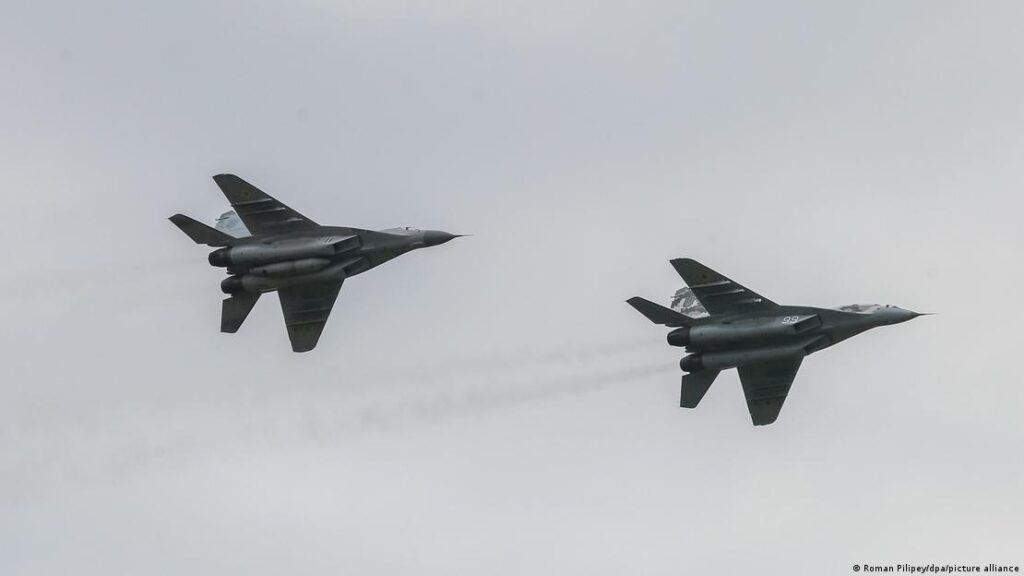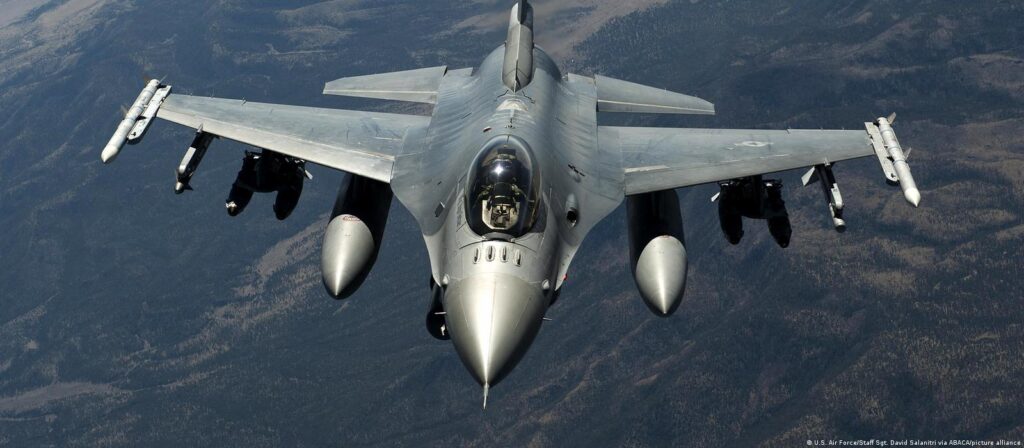After months of denials, the White House gives in to pleas and gives the green light to send fourth-generation fighters and will support pilot training.
After several denials from the White House, President Joe Biden finally gave in to pleas from Ukraine and European allies for F-16-type fighter jets on Friday (5/19).
Ukrainian President Volodimir Zelenski is expected to discuss details of the shipment with Biden during the G7 summit in Hiroshima, Japan.
What exactly has Ukraine been promised?
The United States will support the training of Ukrainian pilots in the use of fourth-generation combat aircraft, including F-16s. While the training is taking place, the United States and the coalition of countries participating in the initiative want to make other decisions: who will provide how many fighters and when.
What is certain is that the training of pilots will take place at sites in Europe (but not in Ukraine), and will begin in the coming weeks and last for months.
The U.S. military estimates that training Ukrainian pilots in the use of F-16s can be completed in four months, provided the pilots are already trained in Soviet-era fighters.
Possible training sites include the U.S. air bases at Aviano in Italy and Spangdahlem in Germany.
It has not been disclosed how many pilots will be trained.
Has the US promised to send fighters?
No. The US government has clearly left this possibility open. What is certain is that the way is open for allied countries to send fighters from their fleets to Ukraine, as President Joe Biden has signaled his approval.
And why does everything depend on the USA?
F-16s are manufactured by the American company Lockheed Martin. So the US government has a central role in the issue, and not only because it has a large fleet, but also because it needs to approve the sending of fighters from allied fleets. And because of the technology used in the jets, it participates in deciding who can be trained. Without a green light from the US, the European partners’ hands would be tied.
The US has, however, made one caveat clear: It is about sending “fourth-generation fighter aircraft, including F-16s.”
What does “fourth generation” mean?
It means that Ukraine will not receive the most modern fighters, the F-35s. In addition, it also means that other models, in addition to the F-16s, may be sent.
Fourth generation fighters also include the Tornados and the Eurofighter used by the Bundeswehr, the French Mirage 2000, and other American models such as the F-15 and the F/A-18 Hornet.
Which countries have F-16s and could send them to Ukraine?
Among the possible suppliers are, besides the USA, the Netherlands, Belgium, Poland, Denmark, and Greece. All of them use F-16s.
“The UK will work with the US, the Netherlands, Belgium and Denmark to provide Ukraine with the air combat capability it needs,” said British Prime Minister Rishi Sunak.
France and the UK, which do not use the F-16, want to participate in pilot training. Portugal has also expressed willingness to contribute to the training of pilots and technicians for F-16 aircraft.
In Germany, Federal Chancellor Olaf Scholz has signaled that he does not want to send F-16s to Ukraine, pointing out that the country already participates in the supply of other weapons, such as Leopard 2 tanks.
And why does Kiev want the F-16s so badly?
Because they are perceived to be effective and because there are many available. Worldwide, more than 2,800 F-16 fighters are in use. So Kiev can expect to receive a large quantity and have less trouble getting spare parts.
The government in Kiev argues that with the Western fighters, it will be able to better defend itself against missile and drone attacks from Russia. To do this, the F-16s would be used in combination with ground-based air defense systems, already provided by the West.
In addition, Ukraine wants to use Western fighters to support ground troops in the offensive against Russia.
Why did the US keep saying no for so long?
The US fears that Western fighters will be used for attacks on Russian territory, which could lead to an escalation of the conflict, also beyond Ukrainian territory.
The Americans also argued that the training of pilots and maintenance technicians is time-consuming, and therefore it would take time for the F-16s to come into use.
The Biden administration also said that it was better to send weapons that the Ukrainians could use at short notice, especially in the expected spring counteroffensive, scheduled to begin soon.
Moreover, F-16s are expensive, and the Republicans, who now have a majority in the House of Representatives, have already threatened not to release any more resources to Ukraine.
On the other side, the Europeans had long pressed for the U.S. to change its position, which the U.S. government never ruled out – also to hold together the alliance of Ukraine’s supporters.
What was Russia’s reaction?
The Russian government has warned that sending F-16 fighter jets to Ukraine would pose “colossal risks” to the United States and its allies. “We see that the Western countries continue in the line of escalation. This implies colossal risks for themselves,” Deputy Foreign Minister Alexander Grushko said, according to Russia’s Tass news agency.
What are fighters like the F-16 and MiG-29 capable of?

Jets like the F-16 or the MiG-29 can change a war, which is why Ukraine would like to have them. But how do they work and what are the differences between them?
When cornering, the pressure of the body against the seat is gigantic. Only people with the highest level of physical fitness can handle it. In addition, it is necessary to wear special pants that allow blood circulation in the legs and prevent the pilot from losing consciousness. The flight rarely has a speed of less than 900 km/h.
“The acceleration is breathtaking.” This is how former German Air Force pilot Joachim Vergin describes the feeling of flying a fighter jet. Perhaps it is comparable to riding a roller coaster – but with forces twice as great, if not more.
It’s a complex challenge that also involves knowing how to use a wide range of weapons. Fighting, dodging, defending yourself. In case of trouble, it is always a matter of life and death – and all this often at the speed of sound.
Strong engine and weapons

It is currently under debate whether or not the West should supply jets to Ukraine, such as the F-16 or MiG-29 models. But which one would be the most suitable?
Jet fighters were first used at the end of World War II. With their engines, they flew much faster than the propeller-driven planes used until then.
A jet engine works as follows: air is sucked into the propeller and compressed. The fuel is then sprayed into the now highly compressed air and ignited.
As a result, the air is pushed “extremely strongly” out of the engine, as Robert Kluge, an aviation expert at the Deutsches Museum in Bonn, Germany, explains. This air then pushes against resistance, either the runway or the surrounding air, accelerating the aircraft.
Fighters can attack targets both in the air and on the ground. For air battles, they are equipped with air-to-air missiles, which can be launched during flight and destroy targets that are also flying. For ground targets, they use air-to-ground projectiles or free-fall bombs, Leonhard Houben, historian at the Berlin-Gatow Museum of Military History, explains to DW.
At the time of construction, aspects such as whether the intention is to use them to fight other aircraft – and whether they can fight back – or whether the plan is to attack ground targets are considered. These strategic considerations are also important when using the technology. Does the plane have to be light and fast for air combat, or does it have to be equipped with large fuel tanks for longer flights?
MiG: Nimble and light
The MiG-29, one of the aircraft being considered for deployment in Ukraine, went into operation with a very clear objective: to protect Warsaw Pact borders against NATO fighters. This means that this interceptor, which entered service in 1983, can take off and reach its target quickly.
Due to its design, the MiG-29 is extremely maneuverable in air combat: it can even stay vertically in the air for short periods of time. However, its initial version carried little fuel, to save weight.
F-16: multipurpose
Most modern fighters combine a variety of capabilities. According to Houben, it is more economical to build so-called multi-mission fighter aircraft because they can be manufactured in large numbers on just one production line.
The F-16 is one such mass-produced multipurpose. It was developed in the US in the 1970s to be sold to partner nations as a low-cost multi-purpose jet. The F-16 is the current jet fighter with the most units in operation in the world. It is still produced in the USA and is constantly being improved.
Houben says that arguably “F-16s built 20 years ago are on the same level as Russian jets built three or five years ago.” One reason is that the development of fighter jet technology was halted in Russia in the 1990s and a lot of talent emigrated.
The Role of Weapons
In addition to technology, weaponry is crucial. Without it, an aircraft is just “a shell, like a fire truck without a magirus ladder,” Kluge compares. Like other experts, he is convinced that if the aircraft are delivered to Ukraine, they will be equipped with a modern weapons package, because only then could the Ukrainians use these planes to protect their airspace.
Unlike anti-aircraft missiles that are fired from the ground, jet aircraft are highly mobile and therefore can protect larger areas and shoot down cruise missiles with air-to-air projectiles. Houben, however, sees Hollywood-style air combat between Russian and Ukrainian aircraft as unlikely, since modern aircraft attack from great distances without being in close contact.
It is somewhat similar to tanks in war: whoever shoots first and hits, wins. Modern air-to-air missiles, once launched, sneak up on the target and show up on radar just before impact. Often, it is too late to avoid the explosion. There is usually little room for twists, machine gun fire, and things that commonly appear in movies.
Training takes years
However, a fighter pilot must also be able to do hand-to-hand combat if all the missiles are fired. In other words, he or she must be able to multitask under extreme conditions. For this reason, pilots are not trained overnight: For the Eurofighter used in Germany, training takes five to six years and costs 5 million euros per pilot.
On the first flight, former pilot Joachim Vergin had a major problem: one of the engines failed. Although he was very scared, he was able to react thanks to the exercises he underwent, remained calm, and landed safely.
Often a pilot learns to fly only one type of fighter and retraining for another takes a long time. When Vergin made the transition from the Phantom model to the Tornado, he had to prepare for seven months.
This is precisely where all the experts heard by DW see the biggest challenge for Ukrainian pilots. All the manuals, all the buttons on the NATO aircraft are in English – and it is not easy to manipulate them when you are Cyrillic literate. Also, the numbers are expressed in feet and miles, while those of the former Soviet Union use metric values.

Jet as myth
In war, however, fighters are more than the sum of their technical capabilities. Kluge describes the jet as a “myth” because, unlike humans, it can also move up and down.
A jet fighter can be seen as a symbol that can boost the troops’ morale. And its mere presence can make enemies think twice before venturing to attack a country.
